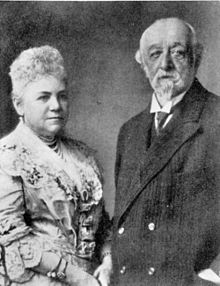Hans Ulrich von Schaffgotsch (mining industrialist)
Count Hans-Ulrich Schaffgotsch , called Semperfrei von und zu Kynast and Greiffenstein, Freiherr zu Trachenberg (born October 16, 1831 in Merseburg , † February 18, 1915 at Koppitz Castle , Province of Silesia ) was a German coal and steel industrialist and parliamentarian in Upper Silesia.
Life
As the son of Wroclaw city commandant Emmanuel Schaffgotsch , Schaffgotsch studied law and camera science at the three Friedrich Wilhelms Universities in Berlin , Wroclaw and Bonn . In 1852 he became a member of the Corps Borussia Bonn . He then went through the usual preparatory service for the administration of justice and the internal administration of the Kingdom of Prussia .
In 1858 he married Johanna Gryczik , who came from a family of miners. She was adopted by the entrepreneur Karl Godulla and made sole heir in 1848. To Schaffgotsches married, it was just before the wedding ennobled . After assuming the inheritance, the company property did not fall to her husband, but was continued under the administration of Countess Schaffgotsch as Johanna's property.
The company owned shares in 60 coal mines and calamine mines (zinc ore mines). On this basis, the couple created the largest zinc production in Germany and expanded coal production. The Schaffgotsch works were one of the four largest mining companies in Silesia around 1900. In 1891 almost five thousand workers were employed in the factories and mines. In 1904, the transition to a corporation as "Gräflich Schaffgotsch'sche Werke GmbH" was completed. In 1912 Schaffgotsch had a fortune of 79 million marks and an annual income of 4 to 5 million marks. He was one of the ten richest Prussian residents. The entrepreneur couple built the Godullahütte site for the workers and also had a church built there.
Schaffgotsch was a state elder and a member of the Free Conservative Party . He was a member of the Prussian House of Representatives from 1868 to 1870 and of the North German Reichstag and the German Reichstag from 1868 to 1874. As a member of the Reichstag, he represented the constituency of Opole District 5 (Bytom).
See also
- Schaffgotsch (noble family)
- List of Corps students in the Reichstag of the North German Confederation and in the Customs Parliament
- List of members of the Reichstag of the German Empire (1st electoral term)
literature
- Friedrich Karl Devens : Biographical corps album of Borussia in Bonn 1827-1902. Düsseldorf 1902. p. 143. ( digital )
- Klemens Skibicki: Industry in the Upper Silesian Principality of Pless in the 18th and 19th centuries . Stuttgart 2002, ISBN 3-515-08036-8 .
- German Biographical Encyclopedia . Vol. 8, p. 750.
- Simon Donig: Social change and new hierarchies - the Silesian magnates as part of a nobility history of the 19th century . ( Digitized version )
Web links
- Hans Ulrich von Schaffgotsch in the database of members of the Reichstag
Individual evidence
- ↑ a b Kösener Corpslisten 1930, 11 , 418
- ↑ Bernhard Mann (edit.): Biographical manual for the Prussian House of Representatives. 1867–1918 (= manuals on the history of parliamentarism and political parties . Vol. 3). Collaboration with Martin Doerry , Cornelia Rauh and Thomas Kühne . Droste Verlag, Düsseldorf 1988, p. 336; for the election results see Thomas Kühne: Handbook of elections to the Prussian House of Representatives 1867–1918. Election results, election alliances and election candidates (= handbooks on the history of parliamentarism and political parties . Vol. 6). Droste Verlag, Düsseldorf 1994, pp. 359-362.
- ↑ Bernd Haunfelder , Klaus Erich Pollmann (edit.): Reichstag of the North German Confederation 1867–1870. Historical photographs and a biographical manual (= photo documents on the history of parliamentarism and political parties . Vol. 2). Droste Verlag, Düsseldorf 1989, short biography p. 461.
- ^ Fritz Specht, Paul Schwabe: The Reichstag elections from 1867 to 1903. Statistics of the Reichstag elections together with the programs of the parties and a list of the elected representatives . 2nd Edition. Carl Heymanns Verlag , Berlin 1904, p. 86.
| personal data | |
|---|---|
| SURNAME | Schaffgotsch, Hans Ulrich von |
| ALTERNATIVE NAMES | Schaffgotsch called Semperfrei von und zu Kynast and Greiffenstein, Freiherr zu Trachenberg, Count Hans-Ulrich |
| BRIEF DESCRIPTION | German coal and steel industrialist and politician, MdR |
| DATE OF BIRTH | October 16, 1831 |
| PLACE OF BIRTH | Merseburg |
| DATE OF DEATH | February 18, 1915 |
| Place of death | Koppitz Castle , Province of Silesia |
